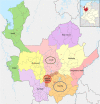Bovine leukosis virus, bovine viral diarrhea, and bovine neosporosis seroprevalence in specialized dairy herds in Antioquia-Colombia
- PMID: 37656253
- PMCID: PMC10474163
- DOI: 10.1007/s11250-023-03685-2
Bovine leukosis virus, bovine viral diarrhea, and bovine neosporosis seroprevalence in specialized dairy herds in Antioquia-Colombia
Abstract
Enzootic bovine leukosis (EBL) is a chronic infectious disease caused by the bovine leukosis virus (BLV), a Deltaretrovirus. Bovine viral diarrhea (BVD) is an infectious disease caused by a pestivirus. Bovine neosporosis is caused by the obligate intracellular parasite Neospora caninum (Nc). These pathogens can have horizontal (postnatal) or vertical (transplacental) transmissions and affect the productive and reproductive performance of infected bovines. This work aimed to detect BLV, BVD, and Nc seroprevalence in specialized dairy cattle from the north, east, and Aburrá Valley regions of the Department of Antioquia, the highest in milk production regions in Antioquia. A total of 599 blood samples, obtained from 53 specialized dairy cattle herds, were evaluated by the ELISA test. The results revealed a seroprevalence of 41.13% for BLV (242/599), 28.48% (163/599) for Nc, and 22.7% (132/599) for BVD. Regarding the regional seroprevalence evaluation, BLV was found in 47.02% of the samples from the east, 36.87% from the north, and 46.02% from the Aburrá Valley. Nc was found in 31.03% of the samples from the east, 24.26% from the north, and 36.63% from Aburrá Valley. BVD was found in 21.62% of the samples from the east, 25.03% from the north region, and 10.39% of the samples from the Aburrá Valley. It is highlighted by these results that the north region, with the highest milk production in Antioquia, had the lowest BLV and Nc seroprevalences but the highest seroprevalence of BVD. BLV has increased in Antioquia in recent years, and as an immunosuppressive infection, opportunities for other pathogens are created by it. A significant statistical difference was found in the average prevalence of the pathogens according to the municipality, cattle breed, and region of origin of the sample. The seroprevalence of these pathogens in specialized dairy herds in Antioquia can be classified as medium-low. However, it is recommended that biosecurity practices should be maximized to avoid the spread of these pathogens due to the variability detected in the region, municipality, breed group, and herd age. The rapid and efficient diagnosis of these three pathogens through reliable methodologies will allow for the control of dissemination in dairy herds.
Keywords: Antibodies; Dairy herds; ELISA; Epidemiology; Milk-producing municipalities; Variability.
© 2023. The Author(s).
Conflict of interest statement
The authors declare no competing interests.
Figures



References
-
- Aguilar, L, 1989. Prevalencia serológica de la leucosis enzoótica bovina en hatos lecheros del municipio de San Pedro Antioquia (Colombia): Universidad de Antioquia, Facultad de Medicina Veterinaria y Zootecnia. Revista Colombiana de Ciencias Pecuarias, 61 p.
-
- Algorta, A., 2014. Leucosis bovina enzoótica en un campo de recría de ganado lechero en el sur del Uruguay (Tesis doctoral en Ciencias Veterinarias inédita). Montevideo (Uruguay): Universidad de la República, Facultad de Veterinaria, 2014, 27 p.
-
- Arauco, F, 2018. Seroprevalencia y factores de riesgo de neosporosis bovina en el Valle del Mantaro-Región Junín, Perú. Revista de Investigaciones Veterinarias del Perú 29:1430. 10.15381/rivep.v29i4.15195
-
- Baker JC. Bovine viral diarrhea virus: A review. Journal of the American Veterinary Medical Association. 1987;190:1449–1458. - PubMed
MeSH terms
LinkOut - more resources
Full Text Sources
Medical

